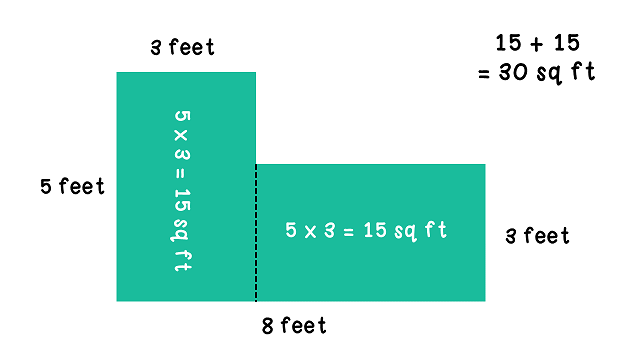Explore area as an attribute of a two-dimensional figure by covering the figure with unit squares without gaps or overlaps. Find areas of rectangles by counting unit squares.
Find the area of a rectangle with whole-number side lengths using a visual model and a multiplication formula.
Solve mathematical and real-world problems involving the perimeter and area of rectangles with whole-number side lengths using a visual model and a formula.
Solve mathematical and real-world problems involving the perimeter and area of composite figures composed of non-overlapping rectangles with whole-number side lengths.
Area can be thought of as tiling, or covering, a surface with equally-sized squares.
Once students understand the tiling concept, they will easily see that area can be found by multiplying the length and width of a rectangle. The concept of area is closely tied to the concept of arrays.
Composite area, or rectilinear area, refers to finding the area of shapes that are made up of rectangles. Once students can see how to "break up" or decompose these figures into their composite rectangles, finding the area is easy!
Just like with rectangular area, the concept of composite area becomes easier for students to understand when they see a tiled version of the figure.
Eventually, students will decompose, or break apart, the figure into composite rectangles. In this example, the figure is divided into two rectangles.
Once the figure is decomposed, students can find the area of each piece, and then add both areas together. Before students do this step accurately, they may need more practice seeing a tiled figure.
This next figure is a little more difficult than the last figure, because it features confusing and misleading side labels. Students need to be able to figure out missing side lengths, even when the labels are confusing.
This represents a common error. Students cut the rectangle as shown, but do not realize that in cutting the rectangle at that location, they have also "cut" 8 into two different numbers.
Tiling can help students see that when they cut 8, they are making it into 3+ 5, in this situation.
The correct answer is shown. In the next section, strategies for helping students understand these cuts are described.

Click here for an area animation.
Click here for a composite area animation.
Perimeter is the length or distance around a 2D object, like this rectangle. Perimeter can be thought of as making a border or fence around a shape.
The most common error that students make with perimeter is just adding the length and width together. It helps to show students a visual of a fence or border, as well as writing in the length and width on all four sides of the rectangle, or all sides of the shape. In this situation, students can see that 5 + 5 + 8 + 8 = 26. Some students may add 10 + 16; some may add 13 + 13; and still others may multiply 2 x 8 = 16 and add that to 2 x 5 = 10.
Students can also find the perimeter of more complex shapes by adding all of the sides together. If sides are not labeled, students will need to use the information in the diagram to find the missing information.
In this diagram, the bottom side is missing. Students can use the information in the rest of the diagram to figure out this missing side length.
Since the top two measurements are 2 and 9, as shown, the bottom measurement is equal to 2 + 9.
In this diagram, the missing side length can be found by considering the answer to the equation 3 + __ = 5. Students will need practice thinking about how opposite sides are equal in a rectilinear figure like this one before they can accurately find missing side lengths on their own.
After finding the missing side length, students add all of the side lengths together to find the perimeter of the shape.